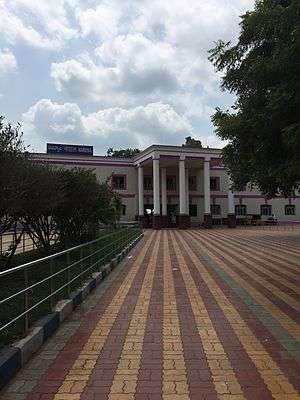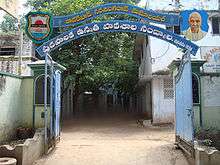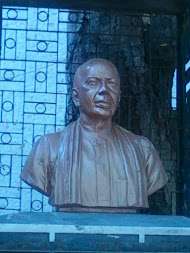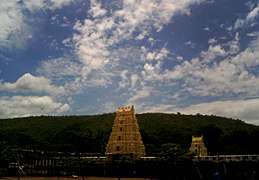Nandyal
Nandyal is a city in Kurnool district of the Indian state of Andhra Pradesh. It is a municipality and the headquarters of Nandyal mandal in Nandyal revenue division.[3][4]. In the 2011 census of India, Nandyal had a population of 211,424 making it the 15th most populous town in the state[2]
Nandyal | |
|---|---|
 Nandyal Junction Main Entrance | |
.svg.png) Nandyal Location in Andhra Pradesh, India | |
| Coordinates: 15.48°N 78.48°E | |
| Country | India |
| State | Andhra Pradesh |
| District | Kurnool |
| Government | |
| • Type | Municipal council |
| Area | |
| • City | 19.00 km2 (7.34 sq mi) |
| Elevation | 203 m (666 ft) |
| Population (2011)[2] | |
| • City | 211,424 |
| • Rank | 19th (in state) |
| • Density | 11,000/km2 (29,000/sq mi) |
| • Metro | 211,424 |
| Languages | |
| • Official | Telugu |
| Time zone | UTC+5:30 (IST) |
| PIN | 518501,518502 |
| Vehicle registration | AP–21 |
| Website | Nandyal Municipality |
Etymology
The town was originally called Nandaluru. It derives its name from Nandi, the Mount of Lord Siva. Aalaya means house/ dwelling in Sanskrit. Since it is surrounded by nine sacred temples of shiva (Nava nandis) it is called Nandi Aalaya which, over period of time, became Nandyala or Nandyal, the present name of the place. These nine temples are Garudanandi, Krishnanandi (also called Vishnunandi), Mahanandi, Naganandi, Prathamanandi, Shivanandi, Somanandi, Suryanandi and Vinayakanandi. These temples draw pilgrims from various places. Nandyal had a population of 200,746 at the time of the 2011 Census.
Demographics
As of 2011 census, the town had a population of 211,424. The total population constitute, 105,826 males and 105,598 females.
History
Nandyal has been an important pilgrimage site since the days of the Vijayanagar Kingdom due to the nine Nandi temples mentioned above. It was the introduction of the railways in 1890, however, that led to its rapid development. It became a municipality in 1900 and was visited, among others, by Mahatma Gandhi, Dr. Rajendra Prasad, Jawaharlal Nehru, Indira Gandhi,P.V.Narasimha Rao, Neelam Sanjeeva Reddy, Pendekanti Venkatasubbiah and many political Leaders across the India.
Geography
Nandyal is surrounded by hills with the Kundu River on its west, the dense forests of Nallamala Hills to the east and granite mines to the south.
The City is rich in water sources like reservoirs. These give it an equitable climate throughout the year. However, summers can be particularly hot. The average temperature is around 28 °C.
Climate
| Climate data for Nandyal (1981–2010, extremes 1966–2012) | |||||||||||||
|---|---|---|---|---|---|---|---|---|---|---|---|---|---|
| Month | Jan | Feb | Mar | Apr | May | Jun | Jul | Aug | Sep | Oct | Nov | Dec | Year |
| Record high °C (°F) | 37.4 (99.3) |
40.5 (104.9) |
43.0 (109.4) |
46.1 (115.0) |
46.0 (114.8) |
45.4 (113.7) |
41.8 (107.2) |
39.7 (103.5) |
37.9 (100.2) |
38.2 (100.8) |
35.5 (95.9) |
36.8 (98.2) |
46.1 (115.0) |
| Average high °C (°F) | 31.8 (89.2) |
34.8 (94.6) |
38.0 (100.4) |
40.3 (104.5) |
40.6 (105.1) |
37.1 (98.8) |
34.4 (93.9) |
33.2 (91.8) |
33.0 (91.4) |
32.5 (90.5) |
31.3 (88.3) |
30.5 (86.9) |
34.8 (94.6) |
| Average low °C (°F) | 16.9 (62.4) |
19.1 (66.4) |
22.2 (72.0) |
25.6 (78.1) |
27.4 (81.3) |
25.9 (78.6) |
24.7 (76.5) |
24.3 (75.7) |
24.3 (75.7) |
23.1 (73.6) |
20.5 (68.9) |
17.5 (63.5) |
22.6 (72.7) |
| Record low °C (°F) | 9.2 (48.6) |
12.0 (53.6) |
12.2 (54.0) |
18.5 (65.3) |
17.1 (62.8) |
17.5 (63.5) |
18.2 (64.8) |
18.5 (65.3) |
16.1 (61.0) |
10.5 (50.9) |
12.7 (54.9) |
9.6 (49.3) |
9.2 (48.6) |
| Average rainfall mm (inches) | 1.3 (0.05) |
0.9 (0.04) |
3.8 (0.15) |
11.6 (0.46) |
50.7 (2.00) |
93.1 (3.67) |
159.5 (6.28) |
155.7 (6.13) |
159.9 (6.30) |
123.2 (4.85) |
26.5 (1.04) |
2.9 (0.11) |
789.1 (31.07) |
| Average rainy days | 0.0 | 0.3 | 0.4 | 1.0 | 2.9 | 5.6 | 8.4 | 8.9 | 8.0 | 6.1 | 2.2 | 0.5 | 44.2 |
| Average relative humidity (%) (at 17:30 IST) | 45 | 39 | 33 | 32 | 35 | 48 | 57 | 60 | 64 | 67 | 63 | 56 | 50 |
| Source: India Meteorological Department[5][6] | |||||||||||||
Economy
The City is a major hub of industry and agriculture. It is rich in natural resources like marble. There are many rice mills and oil mills and Cotton mills and industries which produce milk, soft drinks, sugar, PVC pipes, etc. Some of the renowned industries in the City are the Vijaya Dairy, Nandi Dairy, Nandi Pipes, Nandi Polymers, S. P. Y. Agro, Nandi Steels, etc.[7][8]
Governance
Civic administration

Nandyal municipality was constituted in the year 1899. The jurisdictional area is spread over an area of 19 km2 (7.3 sq mi).[1] Its urban agglomeration is spread over an area of 28.88 km2 (11.15 sq mi) which includes constituents of Nandyal municipality, out growths of Moolasagaram, Noonepalle and partial outgrowths of Udumalpuram, Ayyalur.[3]
Politics

Pendekanti Venkatasubbaiah was an Indian politician. He was the Governor of Bihar from 15 March 1985 to 25 February 1988 and the Governor of Karnataka, India from 26 February 1988 to 5 February 1990. He was elected to the Lok Sabha from Nandyal (Lok Sabha constituency) six times and was the Union Minister of State for Home and Parliamentary Affairs in both Indira Gandhi and Rajiv Gandhi cabinet.
P.V. Narasimha Rao was an Indian lawyer, politician, and activist who served as the ninth Prime Minister of India (1991–1996), registered his record-breaking victory in 1992 from Nandyal (Lok Sabha constituency). Neelam Sanjiva Reddy, the sixth President of India, serving from 1977 to 1982, and the only person to be elected President of India unopposed, fought the Lok Sabha election from Nandyal constituency as a Janata Party candidate. He was the only non-Congress candidate to get elected from Andhra Pradesh in that Loksabha elections. He was unanimously elected Speaker of the Lok Sabha on 26 March 1977.
Silpa Ravichandra Kishore Reddy from YSRCP is the current MLA (2019-) of Nandyal. Pocha Brahmananda Reddy is serving as the member of parliament (MP) from Nandyal (Lok Sabha constituency).
Culture and tourism

As mentioned and listed above, Nandyal is surrounded by nine sacred temples known as the Nava Nandi. Sri Yaganti Uma Maheswara Temple near Nandyal has one of the largest Nandi idols of the world. As per the Archaeological Survey of India, the rock grows at a rate of 1 inch (2.5 cm) per 20 years. Nandyal is also the gateway to Belum Caves, Mahanandi and Srisailam.[9]
Transport
The City is well connected by road and railways. The NH18 [ presently National Highway 40 (India) (NH 40)] is well connected to Kurnool, Tirupathi, Kadapa etc. The Andhra Pradesh State Road Transport Corporation operates bus services from Nandyal bus station.[10] Nandyal Junction is administered under Guntur railway division of South Central Railways.[11] Kurnool Airport which is being constructed at Orvakal to be commissioned in July 2018 is 50 km from Nandyal
Education
The primary and secondary school education is imparted by government, aided and private schools, under the School Education Department of the state.[12][13] The medium of instruction followed by different schools are Telugu,English and Urdu.
See also
References
- "Basic Information of Municipality". Municipal Administration & Urban Development Department. Government of Telangana. Archived from the original on 14 October 2015. Retrieved 24 September 2015.
- "Telangana (India): Districts, Cities, Towns and Outgrowth Wards – Population Statistics in Maps and Charts". citypopulation.de.
- "District Census Handbook – Kurnool" (PDF). Census of India. pp. 12–13, 38, 50. Retrieved 28 August 2015.
- "Kurnool District Mandals" (PDF). Census of India. p. 339. Retrieved 19 January 2015.
- "Station: Nandyal Climatological Table 1981–2010" (PDF). Climatological Normals 1981–2010. India Meteorological Department. January 2015. pp. 539–540. Archived from the original (PDF) on 5 February 2020. Retrieved 19 February 2020.
- "Extremes of Temperature & Rainfall for Indian Stations (Up to 2012)" (PDF). India Meteorological Department. December 2016. p. M15. Archived from the original (PDF) on 5 February 2020. Retrieved 19 February 2020.
- "Brief Industrial Profile of Kurnool District" (PDF). Ministry of Micro, Small & Medium Enterprises. Government of India. pp. 11–12. Retrieved 28 June 2015.
- "Basic Information of Municipality". Municipal Administration & Urban Development Department. Government of Andhra Pradesh. Archived from the original on 29 November 2014. Retrieved 28 June 2015.
- "Imperial Gazetteer2 of India, Volume 18, page 363 -- Imperial Gazetteer of India -- Digital South Asia Library". uchicago.edu.
- "Bus Stations in Districts". Andhra Pradesh State Road Transport Corporation. Archived from the original on 22 March 2016. Retrieved 9 March 2016.
- "Kolakalur railway station info". India Rail Info. Retrieved 30 July 2014.
- "School Education Department" (PDF). School Education Department, Government of Andhra Pradesh. Archived from the original (PDF) on 27 December 2015. Retrieved 7 November 2016.
- "The Department of School Education - Official AP State Government Portal | AP State Portal". www.ap.gov.in. Archived from the original on 7 November 2016. Retrieved 7 November 2016.